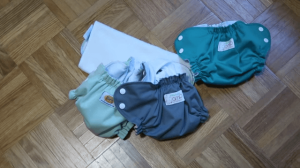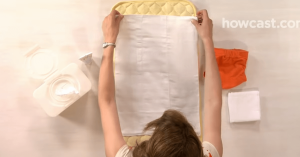How Often do You Change a Cloth Diaper-[Guide2023]

Changing a cloth diaper may seem straightforward—switch it when wet or soiled, right? Well, there’s more to it than meets the eye. The frequency of diaper changes can vary based on your baby’s age, individual needs, and the type of diaper you use. Let’s dive into the details to understand when and How Often do You Change a Cloth Diaper.
The Basics: When to Change
The golden rule of cloth diapering is to check and change diapers every 1.5 to 2 hours during the daytime. It ensures your baby doesn’t stay in a wet diaper for extended periods, reducing the risk of discomfort or diaper rash. However, older babies might be comfortable for more extended periods between changes.
Baby’s Age Matters
Babies of different ages have different output patterns. Newborns, for instance, tend to urinate more frequently than older infants and toddlers. It means you may need to change their diapers more often. As your baby grows, you’ll learn their elimination routine and can adjust your diaper-changing schedule accordingly.
Diaper Absorbency

The diaper’s absorbency determines how often you should change it. Diapers with higher absorbency levels can stay dry for more extended periods. Pay attention to the number of inserts in the diaper, which affects how quickly the diaper becomes wet. More inserts mean urine is better distributed, reducing wetness.
Immediate Diaper Changes
When it comes to soiled diapers there’s no time to waste. These should be changed immediately, whether it’s day or night. A clean and comfortable environment for your baby is a top priority.
Day-to-day variations in fluid output
New parents might not realize that babies have varying fluid outputs at different times of the day. A helpful estimate can provide insights into these fluctuations, which can be influenced by factors such as diet, age, health, medications, fluid quantity, and the time of liquid consumption.
Estimated Fluid Output in Newborns (in ounces):
- 7 AM-3 PM: 19.49 oz.
- 3 PM-11 PM: 26.12 oz.
- 11 PM-7 AM: 31.93 oz.
- Total (24 hours): 77.50 oz.
Fluid Output by Age
Fluid output patterns change as your baby grows. Here’s a breakdown by age:
- Newborn (0-4 weeks): 3.23 oz per hour, 6.46 oz every 2 hours, 12.92 oz every 4 hours.
- Infant (1-12 months): 0.6-1.2 oz per hour, 1.2-2.4 oz every 2 hours, 2.4-4.8 oz every 4 hours.
- Toddler (1-3 years): 1.96-2.8 oz per hour, 3.92-5.6 oz every 2 hours, 7.84-11.2 oz every 4 hours.
- Preschool (3-5 years): 1.96-2.8 oz per hour, 3.92-5.6 oz every 2 hours, 7.84-11.2 oz every 4 hours.
- School-age (5-11 years): 1.96-2.8 oz per hour, 3.92-5.6 oz every 2 hours, 7.84-11.2 oz every 4 hours.
Adjusting to Solid Foods
Older babies need fewer diaper changes as they transition to solid foods and gain more control over their bladder. You’ll notice that fluid output tends to stabilize after the toddler years.
How Many Diapers Do You Need?
Ensure you have enough diapers: Following are some recommendations.
- Diapers for newborns: 20-24
- From 6 to 12 months: 14-18 diapers
- Between 12 and 24 months: 12-16 diapers
- Potty training: four to eight diapers
Quantity of Covers
You’ll need waterproof covers and absorbent diapers using a two-piece diaper system. Here’s a breakdown of cover recommendations:
- Newborn-9 months: 1 wrap for every three diapers
- 9 months-18 months: 1 wrap for every four diapers
- 18 months to potty: 1 wrap for every five diapers
Boosting Absorbency
Add this layer to avoid discomfort and ensure uninterrupted sleep for you and your baby. This additional layer can prevent you and your baby from waking up due to discomfort.
The Transition from Disposable to Cloth
If switching from disposable diapers to cloth, be prepared for a transition phase. Disposable diapers are highly absorbent and can make your baby’s skin drier, causing them to produce extra moisture. During this phase, cloth diapers might need more frequent changes, possibly every hour at the start.
The Importance of Pre-washing
Brand-new diapers may only reach their maximum absorbency once washed around eight times. Hence, new diapers require more frequent changes than older, fully prepped ones.
Baby’s Diaper Fit
Achieving the right fit for your baby’s diaper is crucial for comfort and effectiveness. Here are some tips for getting the perfect fit:
- Use the right size diaper for your baby. If it’s too small, it may be uncomfortable; if it’s too big, it could cause leaks.
- Pay attention to the design and features of the diaper. Some have extra padding or special channels to prevent leaks.
- Ensure the diaper fits snugly around your baby’s waist and thighs to avoid any leakage.
- Checking for proper fit can also help prevent discomfort and irritation.
Every baby is unique, so it may take some trial and error to find the perfect fit for your child. However, taking the time to ensure a comfortable and snug fit will pay off in the long run.
Washable Diaper Liners vs. Disposable Diaper Liners
Diaper liners can help with clean-up and maintaining your baby’s comfort. Here’s a quick comparison of washable and disposable liners:
Washable Diaper Liners:
- Washable diaper liners are economical, eco-friendly, and reusable. They wick moisture away from the skin to prevent rashes. Place the liner in the diaper for easy use.
Disposable Diaper Liners:
- Disposable diaper liners are flushable, absorbent, and ideal for on-the-go diaper changes.
. When it comes to choosing between washable and disposable diaper liners, it ultimately depends on your personal preferences and lifestyle.
Pocket Diapers
If you’re considering cloth diapering, you’ll be glad to know that pocket diapers are a great option. They offer a lot of versatility and can be tailored to meet your baby’s unique needs. One of the best things about pocket diapers is that you can choose the absorbent material that works best for you, whether it’s microfiber, hemp, or bamboo. So, you can rest assured that your baby will be comfortable and dry.
Diaper Covers
When cloth diapering, diaper covers are a great addition. They come in various materials such as wool, cotton, and synthetic.: When choosing a diaper cover, consider the following factors:
- Wool covers: Provide warmth, breathability, and are eco-friendly.
- Cotton covers: Affordable and breathable, preventing rashes.
- Synthetic covers: Budget-friendly but may not be as breathable.
Select a diaper cover that fits well, is comfortable for your baby, and is easy to change to avoid leaks and discomfort.
Quick overview on How to Change a Cloth Diaper?
To effectively change a cloth diaper, follow these steps:
- Remove solid waste from the diaper. Use a bidet sprayer connected to the toilet.
- Put the rinsed-off diaper in a soiled diaper bag or pail for washing later. Ensure your pail has good air circulation to reduce odors.
- Maintain a regular laundry routine every 2-3 days to prevent diaper rash and keep cloth diapers in good condition. Whenever possible, hang the diapers out to dry in the sun for added freshness and disinfection.
Read more details
FAQS
Q-1 How often do you change cloth diaper inserts?
The frequency of changing cloth diaper inserts varies depending on factors like your baby’s age and the type of insert used. For newborns, changing inserts every 2-3 hours is recommended. As infants develop and age, you can gradually increase the duration between diaper changes.
However, continuously monitor for wetness and change to keep your baby comfortable. Eventually, as the inserts lose absorbency, you may need to replace them to maintain effectiveness.
Q-2 why cloth diapers are bad?
Cloth diapers are often considered less absorbent than disposable diapers. It can lead to more instances of diaper rash, especially in scenarios where the cloth diaper is not changed frequently. Babies with sensitive skin might be more prone to developing diaper rash with cloth diapers. Additionally, when babies sleep for extended hours without frequent diaper changes, cloth diapers may not provide the same dryness and moisture-wicking as disposable alternatives, contributing to diaper rash.
Q-3 How many cloth diapers do I need?
The number of cloth diapers you need varies with your baby’s age and your laundry habits. Typically, having 36 for newborns, 24 for infants, and 20 for toddlers is a good starting point.
Q-4 How to use cloth diaper with inserts?
When using cloth diapers with inserts, start by placing the soft fleece side against the baby’s skin. For light wetters during the day, one insert is sufficient, while heavy wetters at night may need two inserts. These inserts can be either slid inside the diaper’s pocket or placed outside it. When it’s time for a change, use the brand tag to easily pull the soiled insert out of the pocket, ensuring a clean removal for washing.
Q-5 How do cloth diapers work with poop?
Cloth diapers use a fleece liner to catch poop, which can be flushed or rinsed for easy cleanup.
Final thoughts on How often do you change a cloth diaper
Determining how often do you change a cloth diaper involves understanding your baby’s age, individual needs, and the diaper’s absorbency. As your child grows, their fluid output patterns will change, and you’ll adapt accordingly. Keep your baby comfortable and clean, and you’ll have a happier diapering experience.
Also read:

